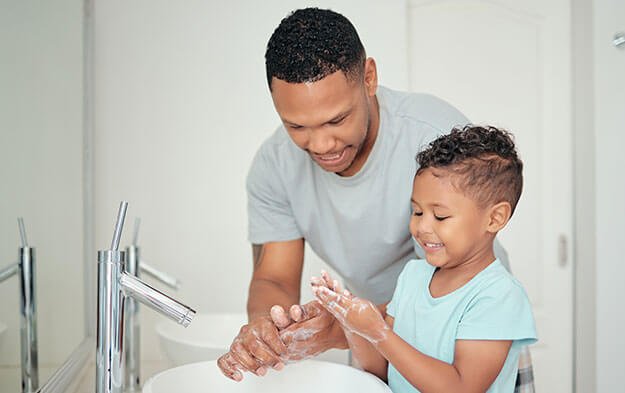Your Guide To Preventing Infection

Tips to avoid cold and flu germs
Washing your hands frequently is one of the easiest, most effective ways to prevent the spread of illness and infection.
Clean hands can stop germs and bacteria from spreading among people—and throughout an entire community. Here are the best ways to clean your hands, cover your coughs, and care for yourself during cold and flu season.
Covering Your Sneeze or Cough
Did you know? Germs are expelled into the air whenever you sneeze or cough.
Prevent the spread of germs:
- Turn away from people before coughing and sneezing.
- Cover your mouth and nose with a tissue when you cough and sneeze.
- Sneeze or cough into the upper sleeve of your shirt if you don’t have tissues.
- Wash your hands frequently and use hand-sanitizing foams or gels.
Caring for Wounds
Did you know? Your skin is your body’s first line of defense against germs. But having an open wound creates an easy path for germs to enter your body.
Always remember to:
- Clean your hands (and wear gloves, if necessary) before and after changing wound dressings.
- Take special care with IV lines or other medical devices inserted into your body. If you must touch them, clean your hands before and after.
- Follow your doctor’s specific instructions and recommendations when caring for a wound.
Identifying Germ “Hot Spots”
Did you know? You can take a few simple steps to ensure your home is a healthy place for you and your family.
Be sure to:
- Disinfect commonly touched hard surfaces, such as countertops, tabletops, light switches, baby changing stations, desks, door handles, fridge and microwave doors, sinks, TV remotes, computers, iPads, gaming devices and controls, and toys.
- Clean with products—like wipes and sprays—labeled disinfectant. These are designed to kill a broad spectrum of harmful bacteria and viruses.
- Use a clean, dry cloth or paper towel to clean and dry all surfaces. Wiping surfaces with a dirty dishcloth, sponge, or towel will only further spread germs.
- Never share toothbrushes, combs, brushes, razor blades, face cloths, bath towels, drinking glasses, or utensils.
Cleaning Your Hands Properly
Did you know? Clean hands are the best protection against spreading germs and preventing infection.
When to clean your hands:
- Whenever hands are visibly dirty
- Before and after eating
- Before and after preparing food
- Before and after touching your mouth, nose, or eyes
- After using the restroom, contact with blood or bodily fluids, changing diapers, and touching animals
Scrubbing with Soap—and Plenty of It
Did you know? It’s important to use plenty of soap with warm/hot running water.
The right technique:
- Wet hands with warm water and work soap into a lather.
- Rub hands vigorously for 15 seconds; scrub wrists, beneath nails, and between fingers.
- Rinse hands with warm running water; pat hands dry with a clean towel.
- Use a clean paper towel to turn off the faucet, then discard towel in trash bin.
Using Hand Sanitizers
Did you know? Using a hand sanitizer for routine hand-cleaning is recommended when your hands aren’t visibly dirty.
How to use sanitizers properly:
- Apply hand-sanitizing foam or gel product in the palm of your hand.
- Rub hands together until they’re dry, ensuring the sanitizing liquid covers every spot on your hands, fingers, and wrists.
- It should take about 15 seconds for your hands to dry after applying sanitizer—if not, you didn’t apply enough.
Looking Out For You
We’re your advocate for a better life!
Call 866-776-6782 to find out how we can assist you or your loved one.


